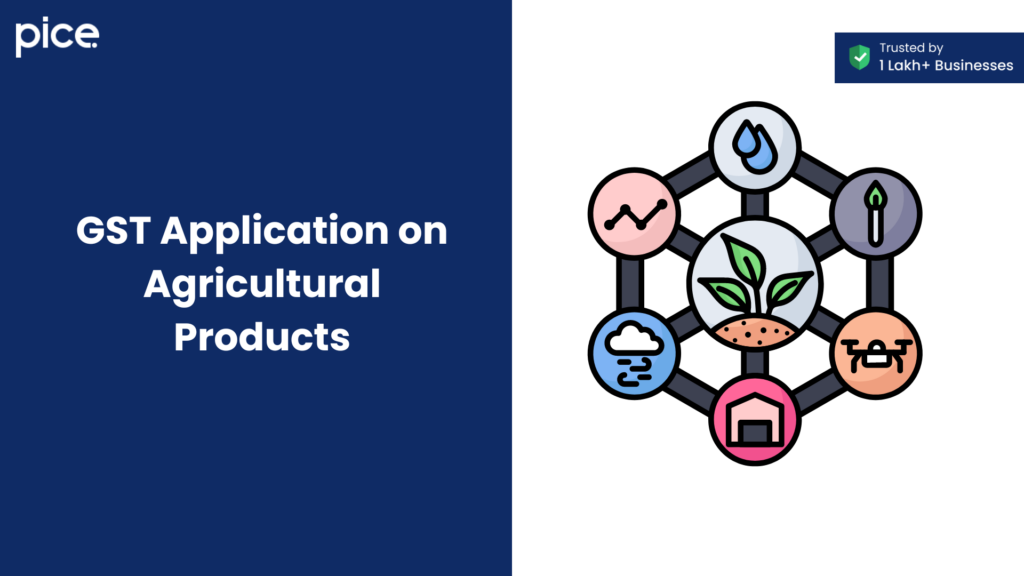Effects of GST on the Agricultural Sector
- 20 Sep 24
- 11 mins

Effects of GST on the Agricultural Sector
Key Takeaways
- GST has simplified the tax structure for the agricultural sector by replacing multiple indirect taxes with a unified tax system, reducing the overall tax burden.
- The availability of input tax credits under GST has lowered the cost of agricultural inputs and improved profitability for farmers and agricultural enterprises.
- Essential agricultural services like land cultivation, animal breeding, and warehousing are exempt from GST, helping to keep operational costs low for farmers.
- GST has enhanced supply chain efficiency by eliminating state-level taxes, leading to faster movement and reduced wastage of agricultural produce.
- The introduction of GST has facilitated the development of a unified national agricultural market, providing farmers with better access to markets and competitive pricing.
The implementation of the Goods and Services Tax (GST) in India has had significant implications across various sectors, including agriculture. As a vital component of the Indian economy, the agriculture sector is the backbone that supports both livelihoods and economic growth. With the introduction of GST, there have been both challenges and opportunities for the agricultural sector.
Overview of the Agricultural Sector in India
The agricultural sector in India is a cornerstone of the economy, contributing approximately 17-18% to the country’s Gross Domestic Product (GDP) and providing employment to over 50% of the Indian workforce. The sector encompasses a wide range of activities, including crop cultivation, dairy farming, animal breeding, and food processing. Agricultural products, such as grains, fruits, vegetables, dairy products, and fresh seafood, form the bulk of India’s food supply and export commodities.
The agriculture industry is highly diverse, ranging from small-scale farmers engaging in subsistence farming to large agricultural enterprises that contribute to the nation’s food security and export earnings. The sector's importance is further highlighted by the government’s efforts to ensure its sustainability and growth through various policies and reforms.
However, the agricultural sector also faces several challenges, including fragmented markets, inefficient supply chains, and high costs of inputs like seeds, fertilizers, and water pumps. These challenges often result in lower farm incomes, an increased burden on farmers, and inefficient utilization of resources. Additionally, the sector has to navigate through the complexities of indirect taxes, which historically added to the costs in agriculture and created barriers to efficient trade and distribution.
Effects of GST on India’s Agricultural Sector
The introduction of GST brought about a significant shift in the way taxes are levied and collected across all sectors, including agriculture. One of the primary effects of GST on the agriculture sector has been the replacement of multiple indirect taxes with a single, unified tax system. Before GST, the agricultural sector was subject to various taxes such as VAT, service tax, and excise duty, which contributed to a higher tax burden and operational inefficiencies.
With the implementation of GST, the agriculture sector has seen a reduction in the overall tax burden. The elimination of cascading taxes—where taxes were levied on top of other taxes—has resulted in a decline in input costs for agricultural products. Farmers and agricultural enterprises can now claim input tax credit (ITC) on the GST paid for inputs like seeds, fertilizers, and equipment. This credit can be used to offset the GST payable on their output, effectively lowering the cost of production and enhancing the competitiveness of Indian agriculture.
Moreover, GST compliance has streamlined the tax filing process for farmers and agricultural enterprises, making it easier to navigate the tax regime. However, the sector also faces challenges, such as the need for awareness among farmers about GST rules and compliance requirements. The initial implementation phase saw some confusion, particularly in understanding how GST applies to different agricultural commodities and services.
Another significant impact of GST on the agriculture sector is the improved efficiency in supply chains. The removal of state boundaries in terms of tax collection has led to a more unified market, reducing delays in the movement of agricultural goods across states. This has had a positive impact on the timely availability of agricultural produce, boosting both domestic supply chains and exports.
GST Application on Agricultural Products

GST applies to a wide range of agricultural products, but the rates vary depending on the nature of the product. Agricultural products, including grains, cereals, fresh fruits, vegetables, and unprocessed food items, generally attract a lower GST rate or are exempt from GST altogether. This is in recognition of their essential nature and their role in ensuring food security.
Processed agricultural products, however, are subject to higher GST rates. For instance, packaged food items, dairy products, and processed fruits and vegetables are taxed at different rates depending on the level of processing and packaging involved. The GST on fruits and fruit juices, for example, varies based on whether the product is fresh, dried, or processed.
💡If you want to pay your GST with Credit Card, then download Pice Business Payment App. Pice is the one stop app for all paying all your business expenses.
The agriculture sector also includes items like agricultural machinery and inputs, such as water pumps and organic manure. These items are crucial for enhancing productivity and efficiency in farming. The GST rates on these inputs are designed to ensure affordability while also generating revenue for the government. The availability of input tax credits on these agricultural inputs further reduces the overall tax burden on farmers and agricultural enterprises.
The introduction of GST on agricultural products has also simplified the tax structure, making it easier for businesses involved in the agriculture industry to comply with tax laws. The unified tax regime has replaced the complex web of taxes that previously applied to agricultural products, leading to more efficient business operations and reduced compliance costs.
Key GST Rates on Agricultural Products
The GST rates on agricultural products are structured to balance the needs of the agriculture sector with the government’s revenue goals. The majority of basic agricultural products, such as fresh fruits, vegetables, grains, and cereals, fall under the zero GST category. This exemption is crucial for ensuring that essential food items remain affordable for the general population.
Processed agricultural products, on the other hand, are subject to GST rates that vary depending on the level of processing and value addition. For example, while fresh milk is exempt from GST, packaged and branded dairy products like cheese and butter attract a GST rate of 12-18%. Similarly, unbranded flour may be exempt, but branded and packaged flour products are subject to GST.
Agricultural machinery and equipment, such as tractors, water pumps, and irrigation systems, generally attract a GST rate of 12%. This rate is set to encourage the adoption of modern farming techniques and equipment, which are essential for improving productivity and reducing labor costs.
The GST rate on agricultural services, including warehousing and cold storage, is also designed to support the efficient storage and distribution of agricultural produce. These services are often taxed at a lower rate or are exempt from GST to promote the development of infrastructure that supports the agriculture sector.
Overall, the key GST rates on agricultural products reflect the government’s focus on promoting agricultural growth while ensuring that essential goods and services remain affordable.
Which Agricultural Services are Exempt Under GST?
Under the GST regime, certain agricultural services are exempt from tax to support the sector's growth and sustainability. These exemptions cover services that are essential for the cultivation, harvesting, and processing of agricultural products, ensuring that farmers and agricultural enterprises can operate with minimal tax burden.
One of the key exemptions is for services related to the cultivation of land, including the supply of water, seeds, and fertilizers. These services are fundamental to agricultural production and are exempt from GST to keep costs low for farmers. The exemption also extends to services provided by agricultural machinery, such as tractors and harvesters, which are crucial for modern farming practices.
Services related to animal breeding, dairy farming, and the supply of organic manure are also exempt from GST. These services are vital for maintaining livestock health and productivity, ensuring a steady supply of dairy products and other animal-based agricultural produce.
Another significant exemption is for warehousing and cold storage services for agricultural produce. These services play a critical role in maintaining the quality and shelf life of perishable goods, such as fruits, vegetables, and fresh seafood. By exempting these services from GST, the government aims to reduce post-harvest losses and support efficient supply chains.
Additionally, services related to the sale of agricultural produce through Agricultural Produce Market Committees (APMCs) are exempt from GST. This exemption ensures that farmers can sell their produce without the additional burden of taxes, promoting fair trade and better income for farmers.
Positive Outcomes of GST on the Agricultural Sector
The introduction of GST has brought several positive outcomes for the agricultural sector, contributing to its growth and modernization. One of the most significant benefits is the reduction in the overall tax burden on agricultural inputs and services, which has led to lower costs of production and improved profitability for farmers and agricultural enterprises.
The availability of input tax credits under GST has also played a crucial role in enhancing the financial sustainability of the agriculture sector. Farmers and businesses can now claim credits for the GST paid on inputs like seeds, fertilizers, and machinery, which can be used to offset the tax payable on their output. This has reduced the effective tax rate on agricultural products and encouraged the adoption of modern farming techniques.
Another positive outcome of GST is the improvement in supply chain efficiency. The unified tax regime has eliminated the need for multiple checkpoints and state-level taxes, leading to faster movement of agricultural goods across the country. This has resulted in a more integrated and efficient agricultural supply chain, reducing wastage and ensuring timely delivery of produce.
GST has also facilitated the development of a unified national agricultural market, enabling farmers to access a broader range of buyers and markets. This has improved price discovery and provided farmers with better opportunities to sell their produce at competitive prices. The National Agricultural Market (eNAM) platform, supported by GST, has further strengthened this process by connecting farmers directly with buyers across the country.
In conclusion, while the implementation of GST posed initial challenges for the agricultural sector, the long-term benefits have been substantial. The reduction in input costs, improved supply chains, and the development of a unified market have all contributed to the sector's growth and resilience. As the sector continues to adapt to the GST regime, it is likely to see even greater efficiencies and opportunities in the future.
 By
By 


















